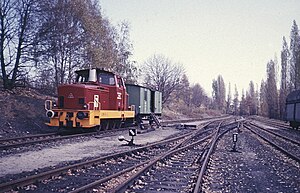Jung R 60 D
| Jung R 60 D | |
|---|---|
|
Locomotive 5 in Spandau OHE station (1986)
|
|
| Numbering: |
OHE DL 4-6 and others |
| Number: | 5 |
| Manufacturer: | Young |
| Year of construction (s): | 1955-1966 |
| Axis formula : | D. |
| Gauge : | 1435 mm ( standard gauge ) |
| Length over buffers: | 10,000 mm |
| Height: | 4,205 mm |
| Width: | 3,120 mm |
| Total wheelbase: | 4,200 mm |
| Service mass: | 60,000 kg |
| Friction mass: | 60,000 kg |
| Wheel set mass : | 15,000 kg |
| Top speed: | Shunting gear 30 km / h, route 60 km / h |
| Installed capacity: | 479 kW (650 hp) |
| Driving wheel diameter: | 1,100 mm |
| Motor type: | MAN W6V22 / 30 A |
| Motor type: | Six cylinder four-stroke diesel engine with supercharging |
| Rated speed: | 920 rpm |
| Power transmission: | hydraulic |
| Brake: | Indirect brake type Knorr |
The type Jung R 60 D was the name given to five four-axle locomotives from the Jung locomotive factory with a diesel-hydraulic rod drive , which were manufactured from 1955 and used in shunting and light freight train services. Some machines have survived to this day.
history
The R 60 D belongs to the third post-war generation of young locomotives, which consisted of a total of seven types. The designation Jung R 60 D was derived from R = shunting locomotive , 60 = about 1/10 of the engine power in HP and D = wheel arrangement .
The first locomotive of the series was the industrial railway of Bayer AG . After six years another three locomotives were delivered to the Osthavelländische Eisenbahn (OHE) . One last copy was used by the Krefeld Railway Company from 1966 .
technology
The locomotive has a front porch for the diesel engine and a rear porch for the gearbox and auxiliary systems. The driver's cab is located between the two . When the first locomotive was delivered, this was done without sun protection screens; it was not given the privacy screen until later. The locomotives delivered later were given the shape of a driver's cab with sun visors ex works.
The basic version of all locomotives had a six-cylinder four-stroke diesel engine. The first machine systems had a very high noise level, which could only be reduced to a tolerable level with an additional silencer on the engine and an additional encapsulation of the flow gear. The power transmission from the engine to the fluid transmission was realized by a long cardan shaft under the cab floor. A secondary gear for maneuvering / main gear and the reversing gear are attached to the fluid transmission . The jackshaft is outside the axle group. The axles are in the frame rigidly.
commitment
The locomotives of the Bayerbahn and the Krefeld Railway Company were in service until around 1980 when they were sold to Italy .
Osthavelländische Eisenbahn DL 4–6
Of the three locomotives, the DL 4 was sold to Italy in the 1980s. Its whereabouts are not known.
The DL 5 remained as a museum locomotive with the company Havelländische Eisenbahn , which was renamed in 2006 , the DL 6 was still available in 2019 and serves as a spare parts donor.
literature
- Stefan Lauscher / Gerhard Moll: Jung-Lokomotiven , EK-Verlag, Freiburg 2014, ISBN 978-3-88255-798-5 , pages 249-256
- Jörg Schulze / Bernd Neddermeyer: Osthavelländische Kreisbahnen - Havelländische Eisenbahn , Verlag Bernd Neddermeyer, Berlin 2012, ISBN 978-3-94171-223-2
Web links
- Jung R 60 D at rangierdiesel.de
- Website with a photo of the Jung R 60 D from 1981 on www.bahnspezl.de
- Photo of a Jung R 60 D taken in 2013 on www.bahnbilder.de
- Website about the Osthavelländische Eisenbahn with a mention of the Jung R 60 D
Individual evidence
- ↑ Type range of the 3rd post-war generation of young locomotives
- ↑ delivered locomotives of the class R 60 D on www.rangierdiesel.de
- ↑ a b Stefan Lauscher / Gerhard Moll: Jung-Lokomotiven , EK-Verlag, Freiburg 2014, ISBN 978-3-88255-798-5 , page 255
- ↑ Data sheet of the prototype locomotive R 60 D from the 1980s
- ↑ Data sheet about the HvLe DL4 locomotive on rangierdiesel.de
- ↑ Data sheet for the DL 5 locomotive from 2015 on rangierdiesel.de
- ↑ Data sheet for the DL 6 locomotive from 2019 on rangierdiesel.de
